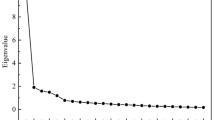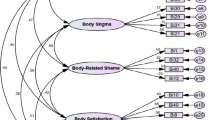Abstract
Background
Breast cancer perception is closely associated with the incidence of breast cancer among community-dwelling women. Consequently, it is crucial to enhance their breast cancer survival rate by assessing their cognitive status and implementing targeted interventions. This study aimed to translate the breast cancer perception scale into Chinese and validate its psychometric properties among community women.
Design
A cross-sectional study method was introduced in this study.
Methods
After obtaining the original author’s authorization, the breast cancer perception scale was translated into Chinese using the Brislin back-translation method. Item analysis was employed to examine the discriminative power of the items, and the Delphi method was utilized to assess content validity. Exploratory factor analysis (EFA) and confirmatory factor analysis (CFA) were conducted to evaluate the scale’s construct validity. Internal consistency and test–retest reliability were calculated to analyze reliability.
Results
A total of 24 items were retained in the item analysis, and the content validity index of the translated scale was 0.964. In the EFA, six common factors were extracted, namely perceived knowledge, perceived treatment belief, perceived need for health checks, perceived stigma, perceived fear, and perceived risk, accounting for 74.911% of the cumulative variance. The CFA results were as follows: χ2/df = 1.301, GFI = 0.903, NFI = 0.913, TLI = 0.975, CFI = 0.978, IFI = 0.979, RMSEA = 0.037. The Cronbach’s α coefficients, split-half reliability, and test–retest reliability of the translated scale were 0.895, 0.661, and 0.865, respectively.
Conclusions
The Chinese version of the breast cancer perception scale demonstrated suitable psychometric properties among community women. By evaluating results according to the scale, medical staff can enhance breast cancer prevention awareness and care for community-dwelling women and subsequently implement corresponding modifications.


Similar content being viewed by others
Availability of data and materials
The datasets used and/or analyzed during the current study are available from the corresponding author on reasonable request.
References
Chiriac VF, Baban A, Dumitrascu DL. Psychological stress and breast cancer incidence: a systematic review. Clujul Med. 2018;91(1):18–26. https://doi.org/10.15386/cjmed-924.
Alkhasawneh E, Al-Farsi Y, Al-Simadi F, Leocadio M. Development and validation of a culturally-tailored breast cancer health education programme for Arab women. Sultan Qaboos Univ Med J. 2017;17(2):e181–90. https://doi.org/10.18295/squmj.2016.17.02.008.
Sung H, Ferlay J, Siegel RL, Laversanne M, Soerjomataram I, Jemal A, Bray F. Global cancer statistics 2020: GLOBOCAN estimates of incidence and mortality worldwide for 36 cancers in 185 countries. CA Cancer J Clin. 2021;71(3):209–49. https://doi.org/10.3322/caac.21660.
Chen W, Zheng R, Baade PD, Zhang S, Zeng H, Bray F, Jemal A, Yu XQ, He J. Cancer statistics in China, 2015. CA Cancer J Clin. 2016;66(2):115–32. https://doi.org/10.3322/caac.21338.
WHO. Global Cancer Observatory: Cancer Today.https://gco.iarc.fr/today/data/factsheets/populations/160-china-fact-sheets.pdf.2021
Tsaras K, Papathanasiou IV, Mitsi D, et al. Assessment of depression and anxiety in breast cancer patients: prevalence and associated factors. Asian Pac J Cancer Prev. 2018;19(6):1661–9. https://doi.org/10.22034/APJCP.2018.19.6.1661.
Barzaman K, Karami J, Zarei Z, et al. Breast cancer: biology, biomarkers, and treatments. Int Immunopharmacol. 2020;84: 106535. https://doi.org/10.1016/j.intimp.2020.106535.
Katsura C, Ogunmwonyi I, Kankam HK, Saha S. Breast cancer: presentation, investigation and management. Br J Hosp Med (Lond). 2022;83(2):1–7. https://doi.org/10.12968/hmed.2021.0459.
Yang Z, Sun L, Sun Y, Dong Y, Wang A. A conceptual model of home-based cardiac rehabilitation exercise adherence in patients with chronic heart failure: a constructivist grounded theory study. Patient Prefer Adherence. 2023;17:851–60. https://doi.org/10.2147/PPA.S404287.
Leung N, Furniss D, Giele H. Modern surgical management of breast cancer therapy related upper limb and breast lymphoedema. Maturitas. 2015;80(4):384–90. https://doi.org/10.1016/j.maturitas.2015.01.012.
Hajj A, Hachem R, Khoury R, et al. Clinical and genetic factors associated with anxiety and depression in breast cancer patients: a cross-sectional study. BMC Cancer. 2021;21(1):872. https://doi.org/10.1186/s12885-021-08615-9.
Zhang C, Hu G, Biskup E, Qiu X, Zhang H, Zhang H. Depression induced by total mastectomy, breast conserving surgery and breast reconstruction: a systematic review and meta-analysis [published correction appears in World J Surg. 2018 Mar 26;:]. World J Surg. 2018;42(7):2076–85. https://doi.org/10.1007/s00268-018-4477-1
Liu N, Li P, Wang J, Guo PP, Zhang XH, Yang S, Yu L, Zhang XM, Zhang W. Factors influencing breast cancer awareness: a cross-sectional study in China. J Comp Eff Res. 2020;9(10):679–89. https://doi.org/10.2217/cer-2020-0037.
Yang L, Wang J, Cheng J, Wang Y, Lu W. Quality assurance target for community-based breast cancer screening in China: a model simulation. BMC Cancer. 2018;18(1):261. https://doi.org/10.1186/s12885-018-4168-1.
Yavan T, Akyüz A, Tosun N, IyigUn E. Women’s breast cancer risk perception and attitudes toward screening tests. J Psychosoc Oncol. 2010;28(2):189–201. https://doi.org/10.1080/07347330903570453.
Euhus DM, Crnp JDM. Breast cancer prevention. Breast J. 2015;21(1):76–81.
Song QK, Wang XL, Zhou XN, Yang HB, Li YC, Wu JP, Ren J, Lyerly HK. Breast cancer challenges and screening in China: lessons from current registry data and population screening studies. Oncologist. 2015;20(7):773–9. https://doi.org/10.1634/theoncologist.2014-0351.
Kanittha C, et al. Protection motivation theory to predict intention of healthy eating and sufficient physical activity to prevent Diabetes Mellitus in Thai population: a path analysis. Diabetes Metab Syndr. 2021;15(1):121–7.
Linsell L, Forbes LJ, Burgess C, Kapari M, Thurnham A, Ramirez AJ. Validation of a measurement tool to assess awareness of breast cancer. Eur J Cancer. 2010;46(8):1374–81. https://doi.org/10.1016/j.ejca.2010.02.034.
Che Mohamed N, Moey SF, Lim BC. Validity and reliability of Health Belief Model Questionnaire for promoting breast self-examination and screening mammogram for early cancer detection. Asian Pac J Cancer Prev. 2019;20(9):2865–73. https://doi.org/10.31557/APJCP.2019.20.9.2865.
Wang X, Chen D, Xie T, Zhang W. Predicting women’s intentions to screen for breast cancer based on the health belief model and the theory of planned behavior. J Obstet Gynaecol Res. 2019;45(12):2440–51. https://doi.org/10.1111/jog.14109.
Taylan S, Özkan İ, Adıbelli D. Breast cancer perception scale: psychometric development study. Eur J Breast Health. 2021;17(2):95–102. https://doi.org/10.4274/ejbh.galenos.2020.6088.
Ni P, Chen JL, Liu N. The sample size estimation in quantitative nursing research. Chin J Nurs. 2010;45(04):378–80.
Hinkin TR. A brief tutorial on the development of measures for use in Survey Questionnaires. Organ Res Methods. 1998;1(1):104–21.
Klotz AC, Swider BW, Kwon SH. Back-translation practices in organizational research: avoiding loss in translation. J Appl Psychol. 2022. https://doi.org/10.1037/apl0001050.
Adawi M, Bragazzi NL, Argumosa-Villar L, Boada-Grau J, Vigil-Colet A, Yildirim C, Del Puente G, Watad A. Translation and validation of the Nomophobia Questionnaire in the Italian language: exploratory factor analysis. JMIR Mhealth Uhealth. 2018;6(1): e24. https://doi.org/10.2196/mhealth.9186.
Huang F, Wang H, Wang Z, Zhang J, Du W, Su C, Jia X, Ouyang Y, Wang Y, Li L, Jiang H, Zhang B. Psychometric properties of the perceived stress scale in a community sample of Chinese. BMC Psychiatry. 2020;20(1):130. https://doi.org/10.1186/s12888-020-02520-4.Erratum.In:BMCPsychiatry.2020;20(1):260.
Ferketich S. Focus on psychometrics. Aspects of item analysis. Res Nurs Health. 1991;14(2).
Zhou CL, Wang SQ, Wang YF, Ou JX, Wu YN. A Chinese version of the Patient perceptions of patient-empowering nurse behaviours scale: reliability and validity assessment in chronically ill patients. J Clin Nurs. 2019;28(3–4):444–57. https://doi.org/10.1111/jocn.14613.
Haynes SN, Richard D, Kubany ES. Content validity in psychological assessment: a functional approach to concepts and methods. Psychol Assess. 1995;7(3):238–47.
Polit DF, Beck CT. The content validity index: are you sure you know what’s being reported? Critique and recommendations. Res Nurs Health. 2006;29(5):489–97.
Wu M. Questionnaire statistical analysis practice: SPSS operation and application. Chongqing: Chongqing University Press; 2010.
Bland JM, Altman DG. Cronbach’s alpha. BMJ. 1997;314(7080):572. https://doi.org/10.1136/bmj.314.7080.572.
Vederhus JK, Timko C, Haugland SH. Adverse childhood experiences and impact on quality of life in adulthood: development and validation of a short difficult childhood questionnaire in a large population-based health survey. Qual Life Res. 2021;30(6):1769–78. https://doi.org/10.1007/s11136-021-02761-0.
Fuhua H, Lili L, Wenzhuan C. A study on the status quo of psychological pain in low-income type 2 diabetic patients based on confirmatory factor analysis. Gen Nurs. 2021;19:2449–54. https://doi.org/10.12104/j.issn.1674-4748.2021.18.001.
Lingling Z, Kunjuan J, Xinran G. Questionnaire validation factor analysis of factors influencing long-term care needs of disabled elderly people. Med Res Educ. 2021;38:59–68. https://doi.org/10.3969/j.issn.1674-490X.2021.05.009.
Euhus D, Di Carlo PA, Khouri NF. Breast cancer screening. Surg Clin North Am. 2015;95(5):991–1011. https://doi.org/10.1016/j.suc.2015.05.008.
Kalager M. Breast cancer screening. BMJ. 2017;359: j5625. https://doi.org/10.1136/bmj.j5625.
ARC Working Group on the Evaluation of Cancer-Preventive Interventions. Breast cancer screening. Lyon (FR): International Agency for Research on Cancer; 2016.
Bao H, Liu L, Cong S, et al. Breast Cancer Awareness and Association with frequency of screening among women - China, 2020. China CDC Wkly. 2023;5(15):327–32. https://doi.org/10.46234/ccdcw2023.063.
Acknowledgements
Thank all participants who provided data for this study, and thank professor Seçil Taylan for providing the breast cancer perception scale.
Funding
No funding was obtained for this study.
Author information
Authors and Affiliations
Contributions
LK did the data collection and analysis and drafted the manuscript, CZ and TL made significant contributions to the collection of data, ZY and HZ made key modifications to the manuscript in order to obtain important academic content.
Corresponding author
Ethics declarations
Conflict of interest
The authors declare that they have no competing interests.
Ethics approval
All the procedures were carried out in accordance with the 1964 Helsinki Declaration, and the research proposal was approved by the Ethics Committee of Jinzhou Medical University (JZMULL2022080).
Informed consent
Before filling in the questionnaire, all participants obtained informed consent to the content and significance of this study, and then filled in anonymously.
Additional information
Publisher's Note
Springer Nature remains neutral with regard to jurisdictional claims in published maps and institutional affiliations.
About this article
Cite this article
Kong, L., Yang, Z., Zheng, C. et al. Psychometric evaluation of the Chinese version of the breast cancer perception scale for community women: a translation and validation study. Breast Cancer 31, 42–52 (2024). https://doi.org/10.1007/s12282-023-01508-8
Received:
Accepted:
Published:
Issue Date:
DOI: https://doi.org/10.1007/s12282-023-01508-8




